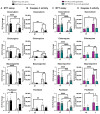Disruption of Man-6-P-Dependent Sorting to Lysosomes Confers IGF1R-Mediated Apoptosis Resistance
- PMID: 40332073
- PMCID: PMC12026698
- DOI: 10.3390/ijms26083586
Disruption of Man-6-P-Dependent Sorting to Lysosomes Confers IGF1R-Mediated Apoptosis Resistance
Abstract
Mutations in GNPTAB underlie mucolipidosis II and mucolipidosis III α/β, which are inherited lysosomal storage disorders caused by a defective UDP-N-acetylglucosamine:lysosomal-enzyme N-acetylglucosamine phosphotransferase. As a result, newly synthesized acid hydrolases fail to acquire Mannose-6-Phosphate (Man-6-P) sorting signals, or do so to a lesser extent, and exhibit an impaired trafficking to lysosomes. Interestingly, we found that GNPTAB knockout HeLa cells are resistant to several cytotoxic agents: doxorubicin, chloroquine, staurosporine and paclitaxel. While we detected an increased trapping of weak bases in the expanded lysosomal population of these cells, which could reduce the effect of doxorubicin and chloroquine; the decreased cell response to staurosporine and paclitaxel suggested the involvement of alternative resistance mechanisms. Indeed, further investigation revealed that the hyperactivation of the Insulin-like Growth Factor 1 Receptor (IGF1R) pathway is a central player in the apoptosis resistance exhibited by Man-6-P sorting deficient cells.
Keywords: GNPTAB; IGF1R; apoptosis; lysosomes; mannose-6-phosphate, M6PR; mucolipidosis II.
Conflict of interest statement
The authors declare no conflicts of interest.
Figures




Similar articles
-
Analysis of mucolipidosis II/III GNPTAB missense mutations identifies domains of UDP-GlcNAc:lysosomal enzyme GlcNAc-1-phosphotransferase involved in catalytic function and lysosomal enzyme recognition.J Biol Chem. 2015 Jan 30;290(5):3045-56. doi: 10.1074/jbc.M114.612507. Epub 2014 Dec 11. J Biol Chem. 2015. PMID: 25505245 Free PMC article.
-
Mice lacking mannose 6-phosphate uncovering enzyme activity have a milder phenotype than mice deficient for N-acetylglucosamine-1-phosphotransferase activity.Mol Biol Cell. 2009 Oct;20(20):4381-9. doi: 10.1091/mbc.e09-05-0398. Epub 2009 Aug 26. Mol Biol Cell. 2009. PMID: 19710420 Free PMC article.
-
The DMAP interaction domain of UDP-GlcNAc:lysosomal enzyme N-acetylglucosamine-1-phosphotransferase is a substrate recognition module.Proc Natl Acad Sci U S A. 2013 Jun 18;110(25):10246-51. doi: 10.1073/pnas.1308453110. Epub 2013 Jun 3. Proc Natl Acad Sci U S A. 2013. PMID: 23733939 Free PMC article.
-
[Lysosomal hydrolases have specific conformational domains for acquisition of mannose-6-phosphate].Nihon Rinsho. 1995 Dec;53(12):2892-7. Nihon Rinsho. 1995. PMID: 8577031 Review. Japanese.
-
Mannose-6-phosphate pathway: a review on its role in lysosomal function and dysfunction.Mol Genet Metab. 2012 Apr;105(4):542-50. doi: 10.1016/j.ymgme.2011.12.012. Epub 2011 Dec 23. Mol Genet Metab. 2012. PMID: 22266136 Review.
References
MeSH terms
Substances
LinkOut - more resources
Full Text Sources
Research Materials
Miscellaneous

